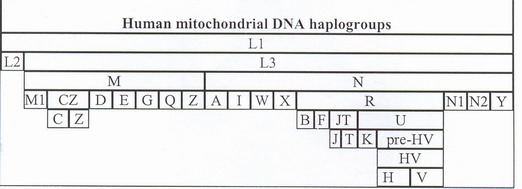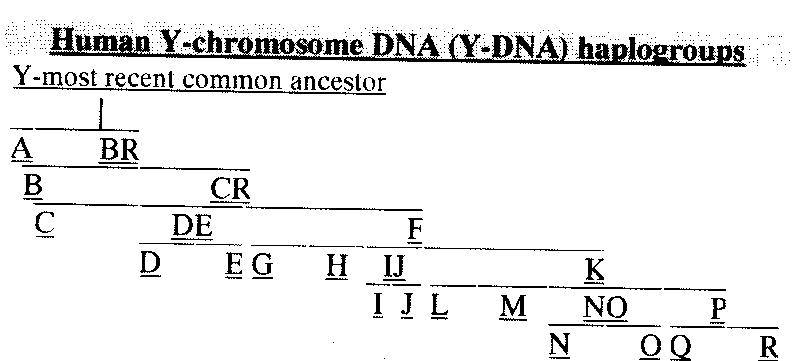New DNA Revelation! (19 September, 2019, 19 Elul, 5779)
DNA can change quickly and dramatically!
It can change in one sweep over whole populations and even theoretically over several different populations and even differing species!
The agent of this change is called "transposon." This is just a technical way of saying "transposition."
The Changes are hereditary.
In DNA Racial classifications we use haplogroups mainly male YDNA haplogroups and female mtDNA haplogroups.
The difference between one haplogroup and another is the addition or deletion of information.
More complex DNA halogroups are assumed to have preceded more simple ones. The simple ones evolved from the complex by losing information.
If theoretically we were to add DNA information to a simple haplgogroup then it would turn into a more complex one, and vice verse.
This is what "transposon" does!
See the DNA tables.


Different explanations are given as to what activates "transposon."
It may be that it is possible through various agents.
The Brit-Am suggestion is that the Genetic Potential exists within the organism to make the change.
Some outside environmental influences then triggers the change when the organism is in need of it.
This explanation would suit the known fact and observed phenomenon from nature.
This means that under certain conditions one DNA Racial Type could change into another DNA racial Type within a very few generations!
=============
Transposable element
https://en.wikipedia.org/wiki/Transposable_element
Extracts:
A transposable element (TE, transposon, or jumping gene) is a DNA sequence that can change its position within a genome, sometimes creating or reversing mutations and altering the cell's genetic identity and genome size.[1]
https://en.wikipedia.org/wiki/Transposable_element
McClintock hypothesized that during cell division certain cells lost genetic material, while others gained what they had lost.[6] However, when comparing the chromosomes of the current generation of plants with the parent generation, she found certain parts of the chromosome had switched position.[6] This refuted the popular genetic theory of the time that genes were fixed in their position on a chromosome. McClintock found that genes could not only move, but they could also be turned on or off due to certain environmental conditions or during different stages of cell development.[6]
McClintock also showed that gene mutations could be reversed.[7]
One family of TEs [transposable Elements] in the fruit fly Drosophila melanogaster are called P elements. They seem to have first appeared in the species only in the middle of the twentieth century; within the last 50 years, they spread through every population of the species.
In peppered moths, a transposon in a gene called cortex caused the moths' wings to turn completely black. This change in coloration helped moths to blend in with ash and soot-covered areas during the Industrial Revolution.
=============
What Darwin Didn't Know About Evolution
https://www.nationalgeographic.com/science/2018/09/darwin-evolution-crispr-microbiome-bacteria-news/
New aspects of evolution have come to light with the introduction of advanced technologies that didn't exist during Darwin's era.
BY SIMON WORRALL
Extracts:
Horizontal gene transfer is essentially sideways heredity. It's the passage of genetic material sideways, from one creature into another, from one species into another. It can even go from one kingdom of life into another, sideways, across great barriers. That was thought to be undoable. I first read about it back in 2013 and my reaction was, 'Wait, what? No! That doesn't happen! That can't happen!'
In fact, genes can go sideways across vast species boundaries. For instance, a gene for resistance to one kind of antibiotic in one form of bacteria, like staphylococcus, can move sideways into another, completely different form of bacteria, say, E.coli. This can happen not just in bacteria but also in animals, plants, and higher organisms, generally as a result of infection or parasitism.
One example is a form of transposon. Big, complicated word. [laughs] What's a transposon? It's a stretch of DNA that transposes from one part of a genome within a creature to another part. But scientists have discovered that these things can also jump from one creature to another, and even from one species to another.
One transposon has been given the name space invaders. It's a long stretch of DNA that invades lots of different organisms. It seems able to pass, for instance, from a reptile into an insect or from a possum into a rat, by way of something called a kissing bug, an insect that, when sucking blood, sucks in some of this transposon. The transposon then moves from one species to another and becomes part of the heritable genome of that new species.
=============
DNA Transposons: Nature and Applications in Genomics
Martun Munoz-Lopez* and Jose L. Garcia-Perez*
https://www.ncbi.nlm.nih.gov/pmc/articles/PMC2874221/
Extract:
As TEs make up a large percentage of genome volume, it is hypothesized that they have participated in changes of genome size during speciation and evolution, as reported in plants [6], Drosophila or primates [7-9]. The trigger(s) for TE-induced genome size increases is not clearly known, although it is thought that stress could be implicated in the amplification of TEs [10]. TEs are able to produce various genetic alterations upon insertion as a consequence of the transposition process (insertions, excisions, duplications or translocations in the site of integration). For example, DNA transposons can inactivate or alter the expression of genes by insertion within introns, exons or regulatory regions [11-15]. In addition, TEs can participate in the reorganization of a genome by the mobilization of non-transposon DNA [16-18] or by acting as recombination substrates. This recombination would occur by homology between two sequences of a transposon located in the same or different chromosomes, which could be the origin for several types of chromosome alterations [19]. Indeed, TEs can participate in the loss of genomic DNA by internal deletions [20] or other mechanisms [21, 22].
